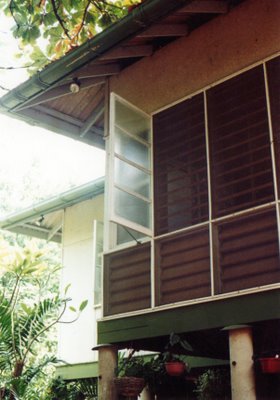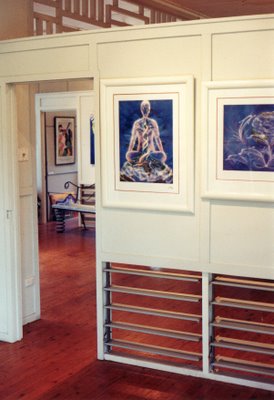 I'm posting these pics here partly because they help to understand the context of the 'shearing shed' that Den posted below. These are photos of one of Darwin's few remaining original, pre-air-conditioning tropical houses, restored after Cyclone Tracy. I took them about ten years ago. As you'll see, many of the features are replicated in Murcutt's own tropical house.
I'm posting these pics here partly because they help to understand the context of the 'shearing shed' that Den posted below. These are photos of one of Darwin's few remaining original, pre-air-conditioning tropical houses, restored after Cyclone Tracy. I took them about ten years ago. As you'll see, many of the features are replicated in Murcutt's own tropical house. They do represent a quite significant achievement: the culmination of British colonial knowledge of how to build in a soakingly hot and humid, termite-ridden, climate. And there is something special about such a simple yet intelligently-designed building in such an extreme setting.
They do represent a quite significant achievement: the culmination of British colonial knowledge of how to build in a soakingly hot and humid, termite-ridden, climate. And there is something special about such a simple yet intelligently-designed building in such an extreme setting. I'll quote from the photo of the signboard (above):
I'll quote from the photo of the signboard (above):Designing for the tropics
Stretching west down Myilly Point [in east-central Darwin] is a group of four tropical houses designed in 1937 by B.C.G. Burnett, principal Government Architect for the Northern Territory. His previous experience in China and Malaya enabled him to understand the local climate. He designed elevated houses with steep-pitched roofs and open eaves to catch the refreshing sea breezes. Further innovations included replacing the external walls with asbestos-cement [ie., fibrolite] louvres that could be adjusted according to the weather conditions. The living areas and bedrooms were separated by three-quarter height partitions to allow for cross-ventilation. Burnett's practical and aesthetic designs established a regional architectural style that continues to influence contemporary housing designs.Burnett's tropical designs are very well known in tropical architecture circles, and were widely emulated, as Murcutt would know and just as he would expect the readers of his own architecure to know. So, I would imagine -- and here I'm speculating-- that Murcutt was intentionally "reinterpreting the colonial response" to the Australian climate in a new "multicultural context." Or something like that. And he would expect his "readers" to be able to "interpret" what he'd "reinterpreted."
 All very "postmodern" in that respect, then.
All very "postmodern" in that respect, then. But I'm posting the photographs for another reason too: simply because this was a bloody nice house to be in, even at the hottest part of the day. "Colonialist," "imperialist" or whatever you want to call him, Mr Burnett had done a very nice job of very intelligently and very simply designing a house for a bloody uncomfortable place in which to live. On this evidence I'd just call him a very fine craftsman, and a pretty intelligent architect.
But I'm posting the photographs for another reason too: simply because this was a bloody nice house to be in, even at the hottest part of the day. "Colonialist," "imperialist" or whatever you want to call him, Mr Burnett had done a very nice job of very intelligently and very simply designing a house for a bloody uncomfortable place in which to live. On this evidence I'd just call him a very fine craftsman, and a pretty intelligent architect.TAGS: Architecture
4 comments:
As I said previously, I appreciated the cooling innovations in DenMT's favourite shed.
But the house you post here has far more comfortable to ~live~ in. The interior is divded up for privacy, the house is on legs tall enough to allow people to shelter underneath it and use it as a porch.
Like Jefferson's Monticello, the bedrooms appear to be orientated so that night time breezes can flow through them. Jefferson actually suspended his bed in line with the draft produced when windows at each end of the room.
Yes, DenMT's shed is the king of shearing sheds.
But for crying out loud, it could have been so much more with a little effort on the part of the architect - both to stretch the concept to the limit and educate/inspire the client into going for it.
That's the thing that pissed me off!
It's like building a Saturn V rocket and celebrating the fact that you can travel to Eketahuna very quickly with it. Well yes, and that's great, but travelling to Eketahuna isn't that great when with a little more imagination you could use the same rocket to travel to the moon.
Mr Burnett is indeed an intelligent designer and pragmatist. Attaching colonial experience to a new environmeent, and allowing the environment to dictate the terms of its colonisation - is how one makes a safe home from a house.
This very tropical house was designed by Beni Carr Glynn Burnett and he is credited with being one of the first architects to design appropriate housing for Australia's tropical north. He was appointed march madness the Australian Government's Principal Architect in the Northern Territory in 1937 and this house is one of five that were designed on this site at Myilly Point a year after his arrival. Four of the houses remain and are all managed by the National Trust.
http://www.enterbet.com
I work at the K house at Myilly Point on saturdays meeting and greeting visitors.
You should visit us when you come to Darwin.
It's a brilliant building.
Good on ya Beni.
Post a Comment